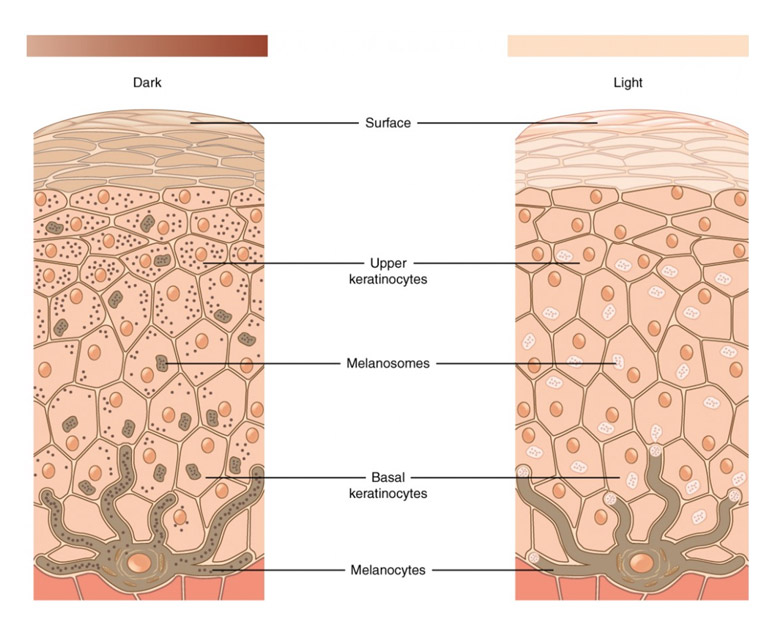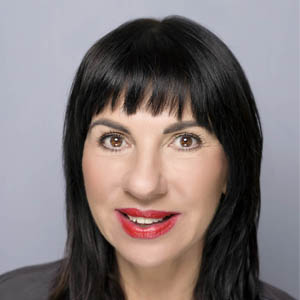
What is Pigmentation?
Pigmentation in the skin results from cells (melanocytes) at the base of the top layer of skin, releasing granules of pigment (melanosomes) into this upper layer. The colour of our skin is determined by how much melanin is contained in the melanosomes.
Normally this is well controlled by our body. Exposure to UV light can excite the melanocytes and cause them to release more melanin to produce a sun tan. Once the exposure is stopped the tanning process ceases and over the following weeks the tan fades as these outer layers of skin cells are shed.
We tend to see changes in pigmentation as a problem when it appears uneven, indicates ageing or signifies a lower social status.
The causes of pigmentation change...
Sun Damage
Pigmentation changes can either be a darkening of the skin – hyperpigmentation or a lightening of the skin hypopigmentation. By far the most common cause of pigmentation change is exposure to UV light in sunlight. every time we get a sun tan we are causing long term damage to our skin. Healthy young looking skin can cover the damage done but as we age the underlying damage becomes more apparent.
The adjacent images compare the visible light image of a young woman with an ultraviolet light image of what is under the surface.
note: The green colour is computer generated and this level of underlying damage is very common.
When this damage accumulates it will typically produce age spots, skin laxity and damage to the skin’s DNA. The melanocytes can also be damaged if there has been extreme exposure. This will appear as light spots of hypopigmentation.
Probably the worst outcome is a malignant skin tumor. These tend to appear as moles that change in shape and or colour. If there is any doubt regardiing the status of a mole you need to urgently have it checked. Ignoring it could prove fatal.
Pollution
Post Inflammatory Hyperpigmentation
Melasma
Treatments Available:
Hydromedi
Hydromedi – hydrofacial treatments use a combination of the suction, turbulence and specially formulated clinical solutions to reach down into the skin and unblock pores, remove blackheads, bacteria, spots and pustules and generally carry pollutants away from the skin. Thus making it perfect for those suffering from acne or congested skin. This stage is then followed by a further stage to hydrate and nourish the skin, leaving you feeling refreshed and rejuvenated. There is no down time and all skin types can be treated.
Led light therapy
LED light therapy has been clinically shown to be helpful for treating a wide range of indications including acne, eczema, psoriasis and rosacea, in addition to skin rejuvenation, accelerated wound healing and the reduction of inflammation and pain.
Picosecond Tattoo & Pigment Removal
What our customers say about us.
Lou knows more than anyone about available procedures. She is warm, supportive, intelligent and operates at the highest standards- she creates them- I have been very lucky to have worked with Lou for many years. She is not anti-ageing, she is pro joy!
Rachel
January 2021
I have been coming to Cosmex for several years now. I would not go anywhere else. Lou is very knowledgeable, professional and always makes me feel relaxed before and during treatments. Super happy with the results.
Sarah
March 2023
The customer care and attention of both Lou and Diana were exemplary. I felt my needs were met in a very relaxed environment and I was very pleased with the outcome from my treatment.
Desda
December 2022
Do you have any questions?
If you’d like to know more about this treatment, please complete the below form. We’d be happy to help.
Clinic Information.
Get in Touch
Address
-
Cosmex Clinic, Maris Lane,
Cambridge, CB2 9LG
Opening Hours
- Monday – 09:00 to 17:30
- Tuesday – 09:00 to 17:30
- Wednesday – 09:00 to 19:00
- Thursday – 09:00 to 17:30
- Friday – 09:00 to 17:30
- Saturday – Closed
- Sunday – Closed

Lou Sommereux
Clinic Director
